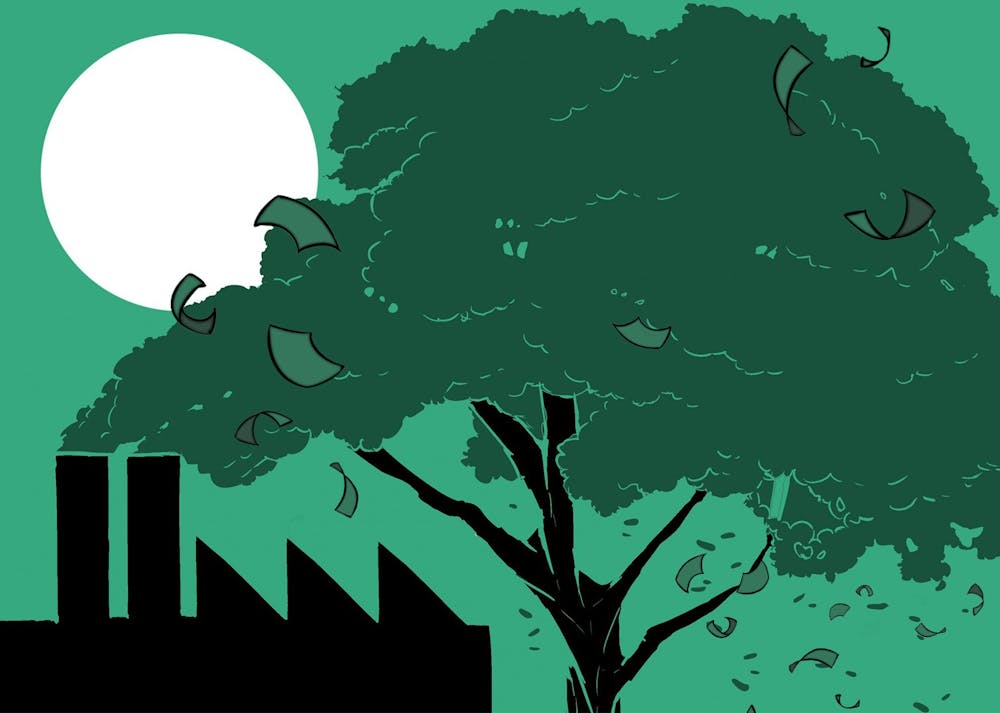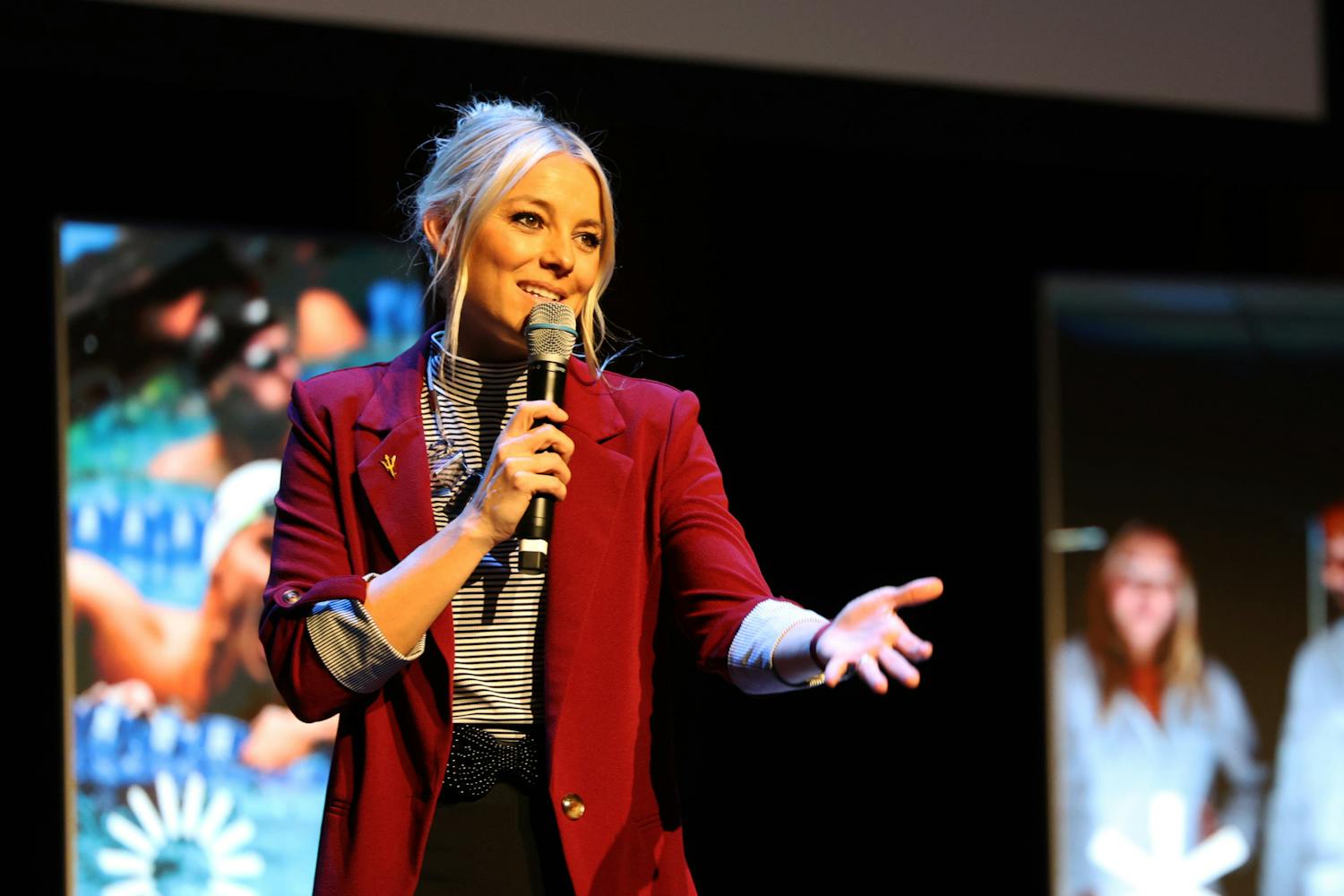In 2007, ASU set an ambitious goal: achieve zero greenhouse gas emissions from campus operations by 2025, a key component to helping mitigate the effects of climate change.
Fast-forward 12 years, ASU announced it met that goal early and attained carbon neutrality. ASU decided to expedite its deadline to meet carbon neutrality goals from the year 2025 to 2019 — a seemingly laborious task. In reality, all the University had to do was buy the allowance to emit more.
When ASU first flaunted a carbon neutrality status in 2020, it had more than halved its gross emissions since 2007 by being more energy-efficient.
But to be carbon neutral, ASU used cash. To obtain the designation, it paid nearly $28,000 to a solar farm in India and over $46,000 to a tree-planting project in Phoenix.
Carbon offsets, the credit permitting ASU to neutralize its pollution, are used by institutions globally to mask emissions with a sustainability title. When the University purchases an offset, it gets a serial number verifying the purchase that allows it to claim neutrality even if its total carbon dioxide emissions are not zero.
Some experts say the vision for true carbon neutrality is a lofty one for any institution, and ASU's claim is more complicated than zero emissions.
The University's zero-carbon status only applies to its direct emissions and electric bill. What is not included is the carbon dioxide the University indirectly contributes, like carbon dioxide emitted by staff’s air travel and from students’ cars as they drive to class.
In fact, ASU's emissions it directly controls increased by 25% from 2007 to 2020, meaning ASU is burning more fuel than it did when it pledged neutrality in 2007.
The carbon offset trading game
Supporting sustainability practices is a feather in ASU’s cap. The University ranked second in universities meeting the United Nations' Sustainable Development Goals in 2022.
The University keeps track of the carbon dioxide it emits, from the direct emissions of its buildings to estimates of its employees’ emissions. But, in its endeavor to reach zero, whatever carbon dioxide the University emitted is canceled out using carbon offsets.
The use of carbon offsets is similar to a trading card game.
Consider two entities: a school and a tree farm. The school is emitting excess carbon and wants to go carbon neutral, and the tree farm is carbon negative — it absorbs more carbon than it emits.
Because it absorbs more carbon than it emits, the tree farm can sell carbon offsets for profit to companies seeking to offset their emissions.
This means the University can purchase carbon offsets from the tree farm and claim carbon neutrality without necessarily changing anything about how much carbon is in the atmosphere.
ASU claimed carbon neutrality because it had zero greenhouse gas emissions after applying carbon offsets toward campus operations, which represent only part of its total carbon dioxide output.
To measure the amount of carbon an institution emits, carbon output is broken down into three categories: scope one, scope two and scope three emissions.
Direct effect: scopes one and two
The emissions ASU directly controls, such as its shuttles and burning fuel on campus, are called scope one emissions, and the emissions the University contributes from purchased electricity, like cooling, are called scope two emissions.
“ASU’s (carbon neutrality) claim is in their scope one and two emissions, which is sort of their more direct emissions, but doesn’t cover some of their more indirect sources like commuting to and from campus, campus travel, the embodied emissions from all the stuff that you buy,” said Julian Dautremont, director of programs at the Association for the Advancement of Sustainability in Higher Education.
But the University does not actually emit zero carbon dioxide from on-campus operations, and a small portion of ASU’s purchased electricity still comes from non-renewable energy sources. After all, it is not as if ASU’s shuttles suddenly stopped emitting carbon dioxide.
Emissions are measured in metric tons of carbon dioxide equivalent, or MTCDE, which ASU reports annually.
Scope one emissions, carbon directly from ASU, have actually increased from over 50,000 MTCDE in the fiscal year 2007 to over 63,000 MTCDE in FY 2020, according to a spreadsheet of ASU's self-reported data obtained by The State Press.
The over 50,000 MTCDE in scope one emissions the University reported in 2007 is equivalent to combusting over 5.6 million gallons of gasoline, according to a conversion calculator created by the Environmental Protection Agency. The over 63,000 MTCDE reported in 2020 is equivalent to combusting over 7.1 million gallons of gasoline.
The University can claim carbon neutrality in scope one thanks to carbon offsets.
From 2007 to 2018, ASU applied a modest amount of carbon offsets. But then in FY 2019, the same year it reached carbon neutrality, the University purchased over $74,000 worth of carbon offsets and applied nearly 60,000 MTCDE of offsets to the carbon it emitted – tens of thousands more than it had purchased years prior, according to an email from University spokesperson Skip Derra.
ASU bought offsets from three different companies since 2017. ASU has purchased credits from Urban Offsets, a company that developed an offset program in Phoenix. It has also bought offsets from Nori, a carbon offset marketplace that provided offsets from Harborview Farms, and from Schneider Electric, which provided offsets from India Solar.
However, offsets run into two big challenges: ensuring that captured carbon is not lost and calculating the amount of carbon captured by a project.
“Guaranteeing the permanence of the storage is a fundamental issue with offsets,” said Klaus Lackner, an ASU professor and director of the Center for Negative Carbon Emissions. For example, the forest that Microsoft claims for carbon storage recently burned down, Lackner said.
To avoid any uncertainty, the University purchases carbon offsets from companies that have met standards endorsed by Second Nature and AASHE, said Alex Davis, interim assistant director for University Sustainability Practices.
Second Nature is an organization that supports and promotes higher education facilities on the pathway to carbon neutrality.
To subtract from its carbon output in scope two, the University purchases renewable energy credits (RECs). While RECs represent the production of renewable energy, purchasing them does not equate to using clean energy but rather a financial endorsement of such.
Because the energy grid is so complex, tracking where one’s energy is actually coming from is difficult. Similar to carbon offsets, RECs are essentially the purchase of the right to claim renewable energy production in one's name.
RECs, unlike other methods of carbon offsetting, are only applicable to the purchase of electricity. For these, the University has purchased both short-term, one-year amounts from various renewable energy facilities, and also has long-term contracts like the Red Rock Solar Project, Davis said.
Scope two emissions, which come from sources such as electricity, heating and cooling systems, contribute to greenhouse gas emissions, but ASU cut down its scope two emissions dramatically by purchasing RECs and slightly from carbon offsets, said Gerald DaRosa, director of energy innovations at the University.
In 2019 the University purchased nearly 297 million kilowatt-hours of RECs, according to University documents, over 42 times more than the University’s first renewable energy purchases in 2011.
The University compiles its carbon emissions from 93 data points for the fiscal year before making any purchase. Once compiled, ASU then purchases the number of offsets and RECs it needs to match its emissions, Davis said.
The nebulous scope three
But it is scope three emissions that notably blur the pathway to institutional carbon neutrality. Thanks to these, measuring an institution's zero carbon emissions is as hard as it is for a camel to fit through the eye of a needle.
This is because scope three emissions include all of an entity’s emissions that it is indirectly responsible for. This estimate includes activities that are not owned by the organization but still fall into its system, such as business or study abroad air travel and commuting, Davis said.
But getting this data is very difficult.
“If you want to know how everyone commutes to the campus they actually have to go and survey people … there's no easy way to get that data, and then it will be incredibly uncertain, still,” said Stephanie Arcusa, a postdoctoral research scholar at ASU's Center for Negative Carbon Emissions.
“The types of actions that ASU can take to mitigate (scope three emissions) are incredibly difficult,” Arcusa said. “I mean, ASU could be like, 'no one is allowed to drive to the campus anymore,' but that’s not right. It’s super difficult to do something about it, despite the fact that scope three emissions are usually the largest.”
Scope three emissions become even more complex because one organization's scope three emissions could also be another’s scope one or two emissions.
For example, ASU’s study abroad travel emissions are quantified under the University's scope three, but they are an airline’s scope one. The emissions an institution such as ASU is responsible for within that scope are complicated to define.
Davis said how an entity calculates its responsibility within scope three is “one of the most complicated and controversial questions out there.” To define what to calculate for its scope three emissions, the University utilizes guidelines laid out by the Second Nature Climate Commitment, of which ASU President Michael Crow is a founding signatory.
Arcusa said the current system is stuck in a reporting scheme that is inefficient and makes people complacent, but it doesn't have to be this way. “There were other ways to account for emissions that wouldn’t have created this mess,” she said.
Instead of everyone scrambling to calculate their carbon emissions, Arcusa said the solution would be requiring the source of all the carbon — the energy industry — to offset its production of fossil fuels. She called it upstream accounting, simplifying who is responsible for carbon emissions by targeting the institutions that have the most control over their carbon emissions. However, this is much easier said than done.
“But how do you tell the fossil fuel industry that they have to do this?" Arcusa said. "We’re obviously seeing there is a lot of pushback already for very simple things."
But if the solution is not begging the fossil fuel industry to change its ways, the second-best solution for carbon reduction, and possibly tackling climate change, might be right here at ASU.
Carbon Capture at ASU
In front of the Biodesign Institute is a conspicuous, black and white, 10-meter-tall metal tower that looks like a massive Bluetooth speaker. The structure is heralded as the first of its kind, a mechanical tree that can passively take carbon out of the atmosphere.
MechanicalTrees, developed by Lackner, are part of a growing family of carbon capture technologies, products that are capable of taking carbon out of the air. Even if humanity stopped emitting carbon today, we would still have too much carbon in the atmosphere, and MechanicalTrees can address that problem, Lackner said.
READ MORE: The world's first mechanical tree prototype to be built at ASU
“It’s not a question of should we just phase out fossil fuels and have it over with,” Lackner said. “We now need to collect CO2 back because we are too late.”
Going forward, the University wants to keep reducing its gross emissions, Davis said.
The carbon captured by MechanicalTrees is stored and can be used for commercial purposes or for canceling out carbon emissions. MechanicalTrees could be the key to offsetting scope three emissions because it does not matter where the carbon it captures came from.
“If it’s accounted properly and if it’s stored properly, it could be an actual answer to what an offset ought to be,” Arcusa said.
Still, as long as ASU spends thousands of dollars on carbon offsets, it will keep its carbon neutrality status as it searches for more solutions.
Reach the reporters at kryback1@asu.edu and cbraggs@asu.edu and follow @KadenRyback and @ConteuseClaire on Twitter.
Like The State Press on Facebook and follow @statepress on Twitter.

Kaden is a reporter for the Biztech desk, focusing on student run business, people profiles and research papers. During his time at The State Press, Kaden's biggest piece was about ASU's history with NASA. He's a sophomore majoring in Journalism and Mass Communication.



